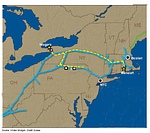A Terrifying Noise: How a small noise on a quiet evening led us to a methane release in Dobbs Ferry...
A beautiful summer evening — four of us having dinner together outside on the terrace below the house. My tenants Danny and Aline Lehrecke had invited me to share their grilled chicken, and we were catching up on events, since I had been away for three weeks. It was a peaceful night, although there were the usual late-day noises: a passing train across the river, a cricket or two, a distant barking dog.
I don’t remember who first noticed the low rumbling sound. Someone said, “I wonder what that is?” It grew louder, and louder, but no one could come up with an explanation. Without a word we went and stood on the lawn above the terrace, looking up toward the source of the noise, which was now so overwhelming that we almost expected something huge to come crashing down on us from above. It was the kind of noise that might have been produced by a tsunami, or a jet engine.
After a few minutes it began to decrease, and finally stopped. I telephoned my daughter Annie, who lives closer to where the sound seemed to be originating. She told me that she had called the police, who put her on hold. In the meantime her brother Tony walked out to the gas line in Tallman Park, where the noise was even louder. He saw a pickup truck parked next to the gas line and a man, wearing a helmet and ear protection, who was turning a valve above the buried pipeline.
The noise returned once more and then stopped. The police eventually were able to tell us that a small leak at a pipeline site on land near the railroad tracks in Dobbs Ferry had been detected late that afternoon. At first they had no explanation for the noise we heard, but later they reported that the noise was caused by the venting of natural gas from the pipeline in Tallman Park to the atmosphere, which had to be done in order to inspect the Dobbs Ferry location, excavate and begin the pipeline repair process.
The 13,900-mile-long Tennessee Gas Pipeline transports natural gas from Louisiana, the Gulf of Mexico and south Texas to the northeast section of the United States, including New York City and Boston.
From Route 303 in Palisades, the pipeline runs south of Oak Tree Road, crosses under Oak Tree Road and the Palisades Parkway to the IBM property, continues east behind the Esplanade and Hey Hoe Woods, then underneath four houses at Snedens Pointe, and finally across Route 9W, entering Tallman Park near the old gas station. It then crosses under the river to Dobbs Ferry. The pipeline is 24 inches in diameter and was put in place in 1955.
There have been concerns about dangers from the pipeline for many years. In 1995 Palisades resident Richard Vickerman stopped a backhoe working south of Oak Tree Road inches above the pipe, one of the largest natural gas pipelines in the country. When the backhoe operator would not stop, Richard called Councilwoman Eileen Larkin and other town officials who acted immediately. Palisades might have been obliterated if they had not stopped the excavation.
Over the course of the week after the mysterious noise Kathy Sykes initiated a correspondence with Richard Wheatley, Director of Corporate and Community Public Affairs at Kinder Morgan, which currently owns the Tennessee Gas Pipeline. The information he gave us was reassuring. On August 5 he wrote, “Upon discovery and confirmation of the leak Friday afternoon, Tennessee Gas activated its emergency response plan, as is normal procedure in such cases, and notified the federal National Response Center of the leak, as well as the Westchester County Department of Emergency Services, area police and fire departments, the New York Public Service Commission and Consolidated Edison and other customers.”
However, in spite of all this information, the Orangetown Police Department at first had no answer to give to the many frightened people who called upon hearing the noise.
But this was not the last word. On August 9 Richard Wheatley informed Kathy that there had not been a leak, but a release of naturally occurring methane on the Dobbs Ferry side. Later I spoke to Don Perkins, the supervisor who had actually dealt with the problem. Someone had reported bubbles of gas coming out of the ground at the location of the pipeline. This had been interpreted as a leak, and our portion of the pipe had been vented. But when they dug down to the pipe, they discovered that the gas bubbles were coming from below the pipe. They were pure methane, naturally released from an accumulation of very old rotting organic material near the river bank.
I was impressed by the cooperation and transparency shown by Tennessee Gas employees. Although it remains a hazard, the pipeline seems to be well looked after. But we in Palisades should continue to be vigilant and aware of the inherent dangers it poses. I will long remember the feeling of dread as I heard the loud roaring from above seem to approach and overwhelm us.


